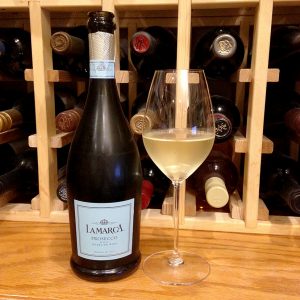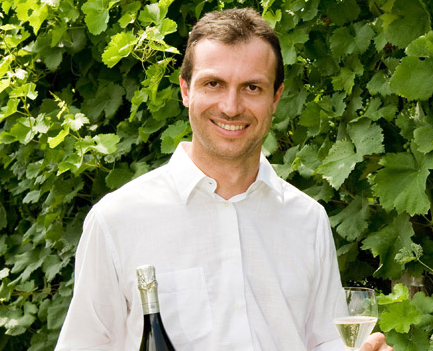Light straw gold with hint of green color; green apple, honeysuckle, peach, yeast on the nose; green apple, ripe peach, lilt of lemon on the palate.

La Marca is on the sweeter side of “extra dry” bell curve, both for the vivid fruitiness and the traces of residual sugar. This is excellent introduction to prosecco. Nice acidity balances the whiff of sweetness. Bright, fresh. Especially refreshing tartness on the finish; 11% ABV.
Good perlage (the column of bubbles that rise in the glass), fun, easy drinker. In addition to mimosa, you can visit the La Marca website to explore other tasty uses—Candied Sapphire (tequila is involved), Orange Blossom (vodka is ingredient), White Lily (gin is in) and more.
By rule, Prosecco is made in the Veneto and Friuli regions of northeastern Italy, primarily with glera grape (must be at minimum 85% of the wine). This is made in the Treviso area using the traditional Charmat method—meaning fermentation is in a pressurized tank instead of inside the bottle. Charmat produces bubbles of slightly different quality and vigor than the traditional in-the-bottle method—creamy is common adjective. Charmat also typically reduces the price to less than $15. As an E.&J. Gallo brand, La Marca is widely available—some 1.9 million cases (almost 23 million bottles) sold in the U.S. in 2017. It is the largest selling prosecco brand in the U.S.
Fabrizio Gatto is the consulting winemaker at La Marca and one of the stars of Italian winemaking. At age 14, he was accepted into the viticultural program at Scuola Enologica de Conegliano (Conegliano Veneto School of Enology) near Venice and in the heart of the province of Treviso where La Marca sources the grapes for its Prosecco. The school is Italy’s foremost wine school—at least for northern Italy—and a major wine research station.

Gatto worked and studied in California after that (he speaks perfect English), then studied at the University of Milan, and later accepted a rare scholarship for work-study in the Rhône Valley of France. He has been head winemaker for Ecco Domani (also a Gallo brand) since its founding in 1995. He is the consulting winemaker for La Marca and led its introduction into the American market. La Marca is a cooperative where hundreds of grape growers bring their grapes to a central winery. This is common practice, especially in Europe where individual grape growers do not have enough acreage to support their own winery. It also explains how La Marca can produced millions of bottles of wine each year.
Gallo is family owned; 14 family members spanning four generations actively work in the business. Gallo’s Modesto, California facility is the largest winery in the world. They also own 14 other wineries in California and Washington, plus overseas efforts such as La Marca.
The Gallos also are responsible land owners. Beginning with the founding of the company by Ernest and Julio Gallo in the 1930s, the company has set aside one acre of property to protect and enhance wildlife habitat for every acre they plant in vines. Gallo was the first U.S. winery to receive the International Standards Organization ISO 14001 certification, a recognition of its efforts to reduce impact on the environment. They also minimize use of synthetic chemicals, fertilizers, and pesticide, recycle and re-use water, and work to create new wetlands and preserve existing riparian habitats. They bring the same commitment to their holdings around the world.
La Marca Prosecco DOC NV is well made introductory prosecco that will please a range of palates with its balance of fruitiness, whisper of sweetness, and brisk acidity. Wonderfully refreshing, subdued alcohol so it can be enjoy any time of day. Virtually all Prosecco wines are wonderful as aperitifs and for sipping on deck, picnic, patio, or poolside. Pair with light fish; shell fish; salad; especially good with fruits; light cheese. $13-14
Very informative video about prosecco with Fabrizio Gatto on Wine Spectator website
